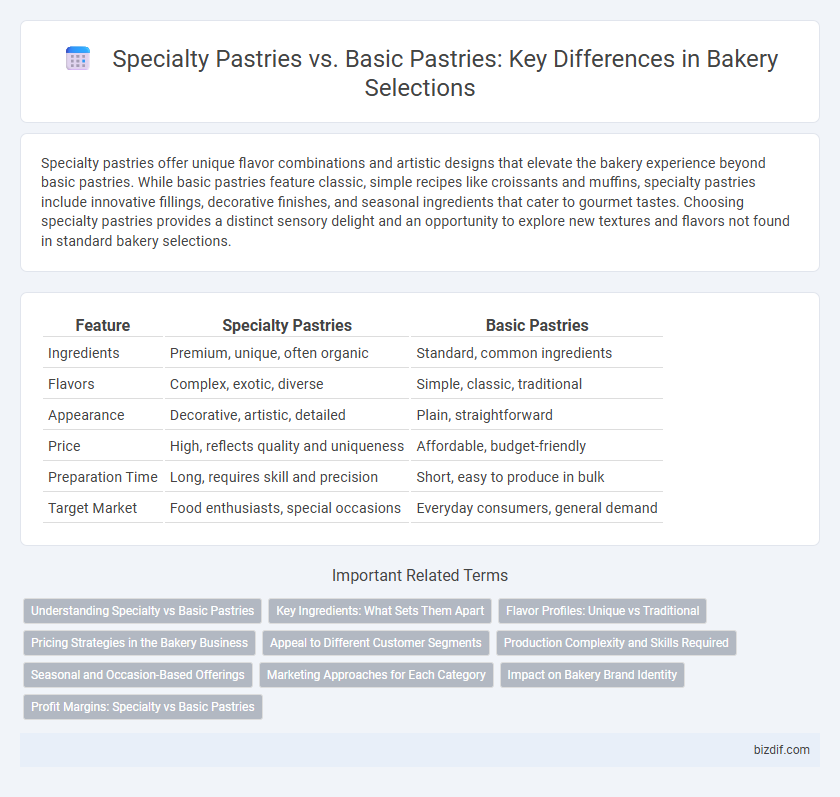Specialty pastries offer unique flavor combinations and artistic designs that elevate the bakery experience beyond basic pastries. While basic pastries feature classic, simple recipes like croissants and muffins, specialty pastries include innovative fillings, decorative finishes, and seasonal ingredients that cater to gourmet tastes. Choosing specialty pastries provides a distinct sensory delight and an opportunity to explore new textures and flavors not found in standard bakery selections.
Table of Comparison
| Feature | Specialty Pastries | Basic Pastries |
|---|---|---|
| Ingredients | Premium, unique, often organic | Standard, common ingredients |
| Flavors | Complex, exotic, diverse | Simple, classic, traditional |
| Appearance | Decorative, artistic, detailed | Plain, straightforward |
| Price | High, reflects quality and uniqueness | Affordable, budget-friendly |
| Preparation Time | Long, requires skill and precision | Short, easy to produce in bulk |
| Target Market | Food enthusiasts, special occasions | Everyday consumers, general demand |
Understanding Specialty vs Basic Pastries
Specialty pastries boast intricate flavors, artisanal techniques, and high-quality ingredients, distinguishing them from basic pastries that emphasize simplicity and mass production. These specialty items often include unique fillings, elaborate decorations, and cultural significance, elevating them beyond everyday bakery staples like croissants or plain muffins. Understanding the distinction helps consumers appreciate the craftsmanship and value behind specialty offerings compared to standard, widely available pastries.
Key Ingredients: What Sets Them Apart
Specialty pastries use premium ingredients such as imported vanilla beans, high-quality European butter, and artisanal chocolates, distinguishing them from basic pastries that typically incorporate standard flour, sugar, and margarine. The unique blends of spices, nuts, and fruits in specialty pastries contribute to richer flavors and textures, elevating the overall taste experience. These key ingredient differences directly impact freshness, aroma, and presentation, making specialty pastries a luxurious choice on any bakery menu.
Flavor Profiles: Unique vs Traditional
Specialty pastries showcase unique flavor profiles by incorporating exotic ingredients like matcha, lavender, or cardamom, creating distinctive taste experiences that stand out in bakeries. Basic pastries rely on traditional flavors such as vanilla, cinnamon, and butter, delivering familiar and comforting tastes that appeal to a broad audience. The contrast between specialty and basic pastries lies in the innovative combinations versus classic flavor foundations that define their sensory appeal.
Pricing Strategies in the Bakery Business
Specialty pastries often command higher prices due to premium ingredients, intricate designs, and limited production, targeting customers seeking unique flavors and luxury experiences. Basic pastries rely on cost-effective ingredients and mass production, allowing bakeries to offer competitive pricing that appeals to budget-conscious consumers. Effective pricing strategies balance ingredient costs, labor, and perceived value to maximize profit margins while maintaining customer satisfaction across diverse market segments.
Appeal to Different Customer Segments
Specialty pastries, crafted with unique ingredients and intricate designs, attract adventurous foodies seeking exclusive flavors and artisanal quality. Basic pastries, including classics like croissants and muffins, appeal to traditional customers valuing consistency, affordability, and everyday enjoyment. Catering to diverse customer segments through varied pastry offerings enhances bakery market reach and customer satisfaction.
Production Complexity and Skills Required
Specialty pastries demand advanced techniques such as laminating dough for croissants or intricate sugar work, requiring skilled bakers with precise control over temperature and timing. Basic pastries, including simple cookies or muffins, involve straightforward recipes and less intricate preparation, making them suitable for novice bakers or high-volume production. The higher production complexity of specialty pastries results in longer preparation times and often necessitates specialized equipment and training.
Seasonal and Occasion-Based Offerings
Specialty pastries often feature unique, seasonal ingredients like pumpkin spice or fresh berries, making them ideal for holidays and special occasions, whereas basic pastries maintain classic flavors such as plain croissants or butter cookies suitable for everyday consumption. Seasonal pastries, like gingerbread during winter or fruit tarts in summer, cater to festive celebrations, enhancing the bakery's appeal during peak periods. Occasion-based offerings, including wedding cakes or Valentine's Day treats, leverage personalized designs and limited availability to attract customers seeking memorable and exclusive baked goods.
Marketing Approaches for Each Category
Specialty pastries often require targeted marketing strategies emphasizing unique ingredients, artisanal craftsmanship, and limited availability to attract niche customers willing to pay premium prices. Basic pastries benefit from broad marketing campaigns that highlight affordability, convenience, and everyday appeal to drive high volume sales and repeat purchases. Leveraging social media storytelling and influencer partnerships can enhance brand perception for specialty pastries, while loyalty programs and bulk discounts effectively boost basic pastry sales.
Impact on Bakery Brand Identity
Specialty pastries, crafted with unique ingredients and artistic presentation, elevate a bakery's brand identity by showcasing creativity and culinary expertise, attracting discerning customers. Basic pastries, while essential for volume sales and meeting everyday demand, offer limited differentiation and contribute less to brand prestige. Emphasizing specialty pastries strengthens customer perception of quality and distinctiveness, driving loyalty and higher profit margins.
Profit Margins: Specialty vs Basic Pastries
Specialty pastries often yield higher profit margins compared to basic pastries due to premium ingredients and unique recipes that justify increased pricing. Basic pastries, while cheaper to produce, typically generate lower margins because of their mass appeal and competitive pricing. Effective cost management and targeted marketing can maximize profitability in both categories within a bakery setting.
Specialty pastries vs Basic pastries Infographic

 bizdif.com
bizdif.com